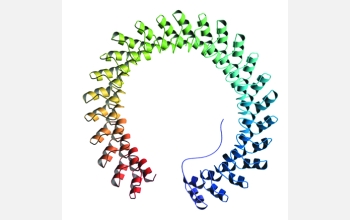News Release 06-009
The Most Resilient Nanosprings in Nature
January 15, 2006
This material is available primarily for archival purposes. Telephone numbers or other contact information may be out of date; please see current contact information at media contacts.
In a discovery that could lead to potent new "shock absorbers" and "gate-opening springs" for molecular-scale nanomachines--as well as a new understanding of mechanical processes within living cells--researchers from Duke University have shown that a component of many natural proteins can act as one of the most powerful and resilient molecular springs in nature.
Known as an "ankyrin repeat," this component occurs in hundreds of different proteins in organisms ranging from plants to humans. In the specialized hair cells of the inner ear, for example, ankyrin repeats may play a critical role in converting sound, a mechanical stimulus, into an electrical signal that can be transmitted to the brain.
Now, the Duke scientists have shown that a sufficiently long string of ankyrin repeats will spontaneously coil into a helical structure, forming a molecule that not only looks like a spring, but functions like one. They published their findings in an advanced online publication of the journal Nature on Jan. 15, 2006.
"Whereas other known proteins can act like floppy springs, ankyrin molecules behave more like steel," said Piotr Marszalek, professor of mechanical engineering and materials science at the Duke Pratt School of Engineering, and one of lead authors on the study. "After repeated stretching, the molecules immediately refold themselves, retaining their shape and strength."
"The fully extended molecules not only bounce back to their original shape in real time, but they also generate force in the process of this rapid refolding - something that had never been seen before," added his co-author Vann Bennett, a Howard Hughes Medical Institute investigator and professor of cell biology at Duke University Medical Center and investigator.
Marszalek and Bennett are participants in the Duke University Center for Biologically Inspired Materials and Material Systems, and were supported in this work by Duke University and the National Science Foundation.
For more information see the Duke University news release.
-NSF-
Media Contacts
M. Mitchell Waldrop, NSF, (703) 292-7752, email: mwaldrop@nsf.gov
Kendall Morgan, Duke University, (919) 660-8414, email: kendall.morgan@duke.edu
Related Websites
Center for Biologically Inspired Materials and Material Systems: http://www.cbimms.duke.edu/
The U.S. National Science Foundation propels the nation forward by advancing fundamental research in all fields of science and engineering. NSF supports research and people by providing facilities, instruments and funding to support their ingenuity and sustain the U.S. as a global leader in research and innovation. With a fiscal year 2023 budget of $9.5 billion, NSF funds reach all 50 states through grants to nearly 2,000 colleges, universities and institutions. Each year, NSF receives more than 40,000 competitive proposals and makes about 11,000 new awards. Those awards include support for cooperative research with industry, Arctic and Antarctic research and operations, and U.S. participation in international scientific efforts.
Connect with us online
NSF website: nsf.gov
NSF News: nsf.gov/news
For News Media: nsf.gov/news/newsroom
Statistics: nsf.gov/statistics/
Awards database: nsf.gov/awardsearch/
Follow us on social
Twitter: twitter.com/NSF
Facebook: facebook.com/US.NSF
Instagram: instagram.com/nsfgov



